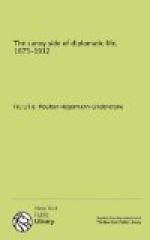The Queen looked exquisite, and seemed to be in the best of spirits. She was the point de mire of all eyes. She wore a superb gown of light-blue brocade, the front entirely trimmed with old Venetian lace. Her necklace and tiara were of enormous pearls and diamonds. She was truly a vision of beauty and queenly grace.
After the quadrille d’honneur the dancing became general. The Queen first talked to the Ambassadresses, then to the wives of the Ministers, sitting down on the bench beside the lady she desired to converse with, the one on the other side moving on discreetly to make more room for the Queen.
The King never came anywhere near the ladies, but talked only with the gentlemen, frequently keeping one by his side and addressing him while he talked with another.
The dancing continued until the Queen had returned from a tour of the other salons, where she had been talking with those assembled there. Re-entering the ballroom, preceded as always by her chamberlains and followed by her ladies, she joined the King, and both, bowing graciously as if to say good night, retired.
[Illustration: QUEEN MARGHERITA Mother of the present King of Italy as she appeared in 1886. The tiara was a present from the King on the preceding Christmas. In the necklace are some of the crown jewels, pearls and six remarkable emeralds.]
ROME, February, 1881.
Dear ——,—Mrs. Elliot brought Ouida to see me on my reception-day. Ouida is, I am afraid, a little bit of a poseuse, but geniuses have privileges which cannot be endured in ordinary people. She was dressed with a lofty disregard of Roman climate and its possibilities, and in utter defiance of common sense. She wore a dress open at the throat, with short sleeves, and the thinnest of shoes and stockings, which she managed to show more than was quite necessary. She spoke in an affected voice, and looked about her continually as if people were watching her and taking notes.
Among the ladies of the Queen here are three Americans who have married Italians and have entered the charmed circle of the court. Their services are only required upon certain gala occasions. One is the daughter of Hickson Fields (whom we used to know so well in Paris), who has married Prince Brancaccio. Another American lady, the wife of Prince Cenci, who is of the same family as the lady with the turban. Both the Prince and the Princess are at court, he as chamberlain and she as dame de palais. He is called the “Boeuf a la mode,” not because he in any way looks like a boeuf, but because he is fine-looking, masterful, and a la mode.
Count Gianotti, first master of ceremonies, has also an American wife. She was a Miss Kinney, a daughter of Mrs. Kinney whom we knew in Washington. She is tall and striking-looking. Her Friday receptions are well attended, especially when she lets it be known that there will be particularly fine music. While the artist at the piano thinks he is making a heavy and great success and is wrestling with his arpeggios on a small piano, the guests come and go and rattle their teacups, regardless of the noise, while the music goes on. This is often the case in Roman salons.




